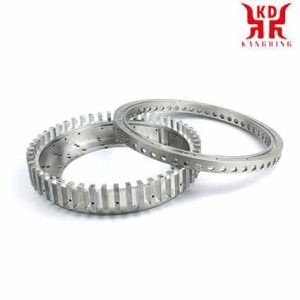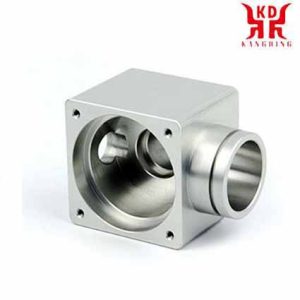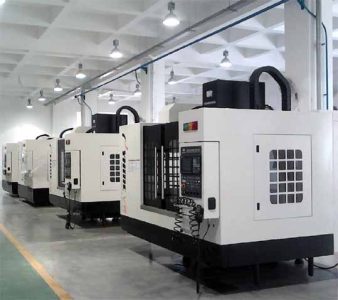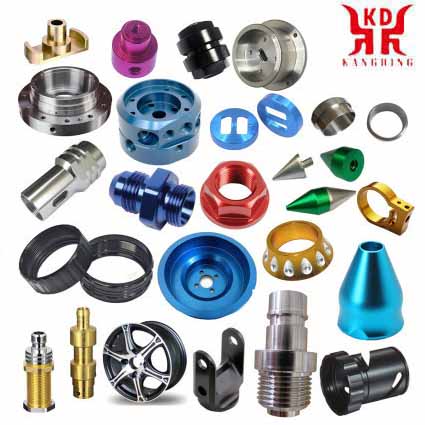Was ist Fräsen?? Was ist der Prozess des Mahlens?? Welche Teile können durch CNC-Fräsen bearbeitet werden?? Welche Präzision können China-Frästeile erreichen??

Was ist Fräsen??
CNC-Frästeile
Wie werden CNC-Frästeile hergestellt??
CNC-Frästeile werden auf CNC-Fräsmaschinen mit Hilfe rotierender Werkzeuge bearbeitet. Zum Einsatz kommen CNC-Fräsmaschinen mit unterschiedlichen Bewegungsfreiheitsgraden: 3-Achse, 4-Achs- und 5-Achs-Fräsmaschinen.
3-axis milling machines can only machine CNC milled parts from one accessibility direction. They are cheaper than the other types of milling machines. 4-axis milling machines have an additional axis of rotation for the milled part, for example for the production of spindles and other helical geometries. 5-axis milling machines can machine CNC milled parts from all sides, depending on the clamping, and also produce complex geometries.
With our supplier network, we can manufacture a wide range of CNC milled parts for a wide variety of requirements.
We specialize in CNC machining, our automatic price calculation is constantly being expanded and currently covers components with the following properties.
Milling consists mainly of cutting the material that is machined with a rotary tool with several edges, called teeth, lips or carbide inserts, which executes programmed advance movements of the worktable in almost any direction of the three Possible axes on which the table where the part to be machined is fixed can be moved.
With the increasing use of numerical control milling machines, the milling operations that can be carried out with this type of machine are increasing, and thus milling has become a multipurpose machining method. The development of the tools has also contributed to create new possibilities of milling in addition to considerably increasing the productivity, quality and accuracy of the operations carried out.
| Our manufacturing options for CNC milled parts
Component dimensions from 2 mm x 2 mm x 2 mm |

cnc milling parts
Milling tools
The milling tools are characterized by their outside diameter, the number of teeth, the pitch of the teeth (understood as the distance between two consecutive teeth) and the fastening system of the cutter on the machine.
Types of milling
In the universal milling machines using the appropriate accessories or in the numerical control milling machines the following Planning can be carried out.
The most frequent application of milling is face milling that aims to achieve flat surfaces. For the face milling milling cutters with interchangeable carbide inserts are generally used, there is a very varied range of diameters of these mills and the number of inserts that each milling cutter mounts. Plattenhersteller empfehlen als erste Option die Verwendung von runden Platten oder alternativ mit 45°-Winkeln.
Quadratisches Fräsen. Das Quadratfräsen ist eine Variante des Planfräsens, die darin besteht, senkrechte Stufen im zu bearbeitenden Teil zu belassen. Dafür, Es werden quadratische Wendeschneidplatten verwendet, die in geeigneter Weise im Werkzeughalter positioniert sind.
Würfelfräsen. Der Würfelvorgang ist bei vertikalen oder horizontalen Fräsmaschinen weit verbreitet und besteht darin, die Metalldübel oder anderes Material wie Marmor oder Granit in den entsprechenden kubischen Abmessungen für nachfolgende Arbeitsgänge vorzubereiten. Auch dieses Fräsen erfolgt mit auswechselbaren Planfräsern.

CNC-Frästeile Arten des Fräsens
Schnittfräsen. Eine der ersten Bearbeitungsoperationen, die durchgeführt werden müssen, besteht häufig darin, die Stücke ausgehend von handelsüblichen Stäben und Profilen größerer Länge auf die festgelegte Länge zuzuschneiden. Für das industrielle Schneiden von Teilen werden Bandsägen oder Fräsmaschinen mit zylindrischen Fräsern austauschbar eingesetzt. Das Besondere an Schneidfräsern ist, dass sie aus Schnellarbeitsstahl oder Hartmetall gefertigt sein können. Sie zeichnen sich dadurch aus, dass sie sehr dünn sind (Im Auftrag von 3 mm, obwohl es variieren kann), mit großem Durchmesser und sehr feinen Zähnen. Ein Beispiel für die Eigenschaften eines Fräsers wäre das Folgende: Durchmesser von 200 mm, Dicke von 3 mm, Durchmesser des Lochs von 32 mm und 128 Zähne: Bußgeld 128, Grob 64.
Gerades Nutfräsen. Zum Fräsen gerader Nuten, Im Allgemeinen und häufig werden zylindrische Fräser mit der Breite der Nut verwendet, to increase production, several cutters are mounted on the cutter shaft allowing to increase machining productivity. The assembly of several cylindrical strawberries is called a train of strawberries or compound strawberries. Cylindrical burs are characterized by having three cutting edges: the front and the two sides. High speed steel burs are used in most applications since carbide burs are very expensive and are therefore only used in very large productions.

CNC-Frästeile Arten des Fräsens
Shape grooving.. Burs of the appropriate shape for the groove are used, which can be T-shaped, dovetail, usw.
Keyway grooving. Cylindrical strawberries with handles, known in slang as ballerinas, are used that can cut both in a direction perpendicular to its axis and parallel to it.
Milling in Copying. Round insert profile cutters are used for copy milling in order to be able to carry out machining operations in orographies and profiles of changing faces. There are two types of copy cutters: those with a half ball profile and those with a round or toric edge.
Cavity milling. In this type of operation, it is advisable to carry out a prior drilling and from there and with suitable milling cutters, approach the cavity machining, bearing in mind that the radii of the cavity must be at least 15% greater than the radius of the milling cutter.
Lathe-milling. This type of machining uses circular interpolation in numerical control milling machines and is used for both precision hole turning and external turning. The process combines the rotation of the workpiece and the milling tool, making it possible to achieve a cylindrical surface. This surface can be concentric with respect to the center line of rotation of the part, or it can be eccentric if the milling is moved up or down. With axial displacement it is possible to achieve the required length.
Thread milling. Thread milling requires a milling machine capable of simultaneous helical interpolation in two degrees of freedom: the rotation of the part with respect to the axis of the helix of the thread and the translation of the part in the direction of said axis.
Face milling. It consists of milling that is carried out with cylindrical helical burs that attack the milling operation frontally. More and more fully integral carbide burs are used in numerical control milling machines that allow working at very high speeds.
Gear milling. Gear milling is hardly carried out on universal milling machines using the dividing plate anymore, but is done on special machines called gear hobbing machines and with the use of special milling cutters of the appropriate tooth module.
Drilling, reaming and boring. These operations are usually carried out on numerical control milling machines equipped with a tool magazine and using the appropriate tools for each case.
Mortising. It consists of machining keyways in the holes, for which broaching machines are used or a special accessory that is attached to the universal milling machine head and transforms the rotation movement into an alternative vertical movement.
Ramp milling. It is a common type of milling in the machining of molds that is done either with copier milling machines or with numerical control milling cutters.
Wie funktioniert die CNC-Fräsmaschine??
The introduction of computerized numerical control (CNC) has exponentially expanded the applications of industrial machines through the programmable automation of production and the achievement of movements impossible to carry out manually, such as circles, diagonal lines and other more complicated figures that allow the manufacture of parts with highly complex profiles. This also translates into the optimization of many essential variables of any manufacturing process: productivity, precision, safety, speed, repeatability, flexibility and reduction of waste.
The multiplicity of milling machines that exist today has comfortably expanded into the proliferation of their CNC-equipped peers. Tatsächlich, there are also special kits to transform old milling machines into a CNC milling machine.
Grundsätzlich, the CNC milling machines are very similar to the conventional ones and have the same moving parts, das ist, the table, the cutting head, the spindle and the side and cross slide carriages. Jedoch, they do not have levers or cranks to operate these moving parts, but rather a screen inserted in a panel full of controls and a metal box that houses the electrical and electronic components that regulate the operation of motors destined to carry out the same work that they did. the levers and cranks of the old machines. Among these components is the CNC, which is a computer mainly responsible for the movements of the milling machine through the corresponding software. The combination of electronics and drive motors or servo motors is capable of achieving all possible milling operations.
To understand the movement control exercised by the CNC, we are going to briefly review how a conventional milling machine works.
The figure schematizes a typical milling machine. In this type of machine, the cranks actuate the moving parts manually so that the cutting tool (milling cutter) moves linearly in at least three axes, which are called main axes:
X axis: horizontal and parallel to the clamping surface of the part. It is associated with the movement in the longitudinal horizontal plane of the milling table.
und Achse: forms a direct direction trihedron with the X and Z axes. It is associated with the movement in the horizontal transverse plane of the milling table.
Z axis: where the cutter is mounted, it is the one that has the cutting power and can adopt different positions according to the possibilities of the head. It is associated with the vertical displacement of the machine head.
If the milling machine has a fixed table, these three movements are executed by the spindle.
Jedoch, Es ist klar, dass das Fräsen komplexerer Teile eine größere Anzahl von Achsen erfordert, deren Bewegungsbahn nicht nur linear ist, aber auch rotierend. An diesem Punkt kommt das Konzept der CNC ins Spiel, Dadurch entsteht eine Vielzahl komplementärer Achsen, die unabhängig voneinander gesteuert und durch die Bewegung von Drehtischen bestimmt werden / oder verstellbare Köpfe. Dadurch entstehen unterschiedliche Maschinenmodelle, die die Bearbeitung des Teils in unterschiedlichen Ebenen und Anstellwinkeln ermöglichen.
In der folgenden Abbildung sehen wir ein Beispiel einer CNC-Fräsmaschine mit ihren Grundkomponenten und Hauptkomponenten (X, Y, Z) und ergänzend (B, W) Achsen.
1 – Spalte
2 – Werkstück
3 – Frästisch, mit Bewegung in der X- und Y-Achse
4 – Drehen
5 – Schneidkopf inklusive Spindelmotor
6 – CNC-Bedienfeld
7 – Kühlmittelschläuche
X, Y, Z – Hauptreiseachsen
B – Complementary axis of rotary displacement of the cutting head
W – Complementary axis of longitudinal displacement of the cutting head

CNC-Frästeile Arten des Fräsens
The main function of the CNC is to control the movements of the table, the transverse and longitudinal carriages and / or the spindle along their respective axes by means of numerical data. Jedoch, this is not all, because the control of these movements to achieve the desired final result requires the perfect adjustment and the correct synchronization between different devices and systems that are part of every CNC process. These include the main and complementary axes, the transmission system, the workpiece clamping systems and the tool changers, each of which presents its modalities and variables that must also be properly stipulated.
This rigorous control is carried out by software that is supplied with the milling machine and is based on one of the CNC numerical programming languages, such as ISO, HEIDENHAIN, Fagor, Fanuc, SINUMERIK and Siemens. This software contains numbers, letters and other symbols – Zum Beispiel, the G and M codes – that are encoded in an appropriate format to define an instruction program capable of carrying out a specific task. G codes are machine motion functions (rapid moves, Einspeisungen, radial feeds, pauses, cycles), while M codes are miscellaneous functions that are required for machining parts, but are not machine motion. (spindle start and stop, Werkzeugwechsel, coolant, program stop, usw.). From this it follows that to operate and program this type of machine requires basic knowledge in machining operations on conventional equipment, elementary knowledge of mathematics, technical drawing and handling of measuring instruments.
Currently, the use of CAD (computer-aided design) and CAM (computer-aided manufacturing) programs is an almost obligatory complement to any CNC machine, which is why, allgemein, the manufacture of a part involves the combination of three types of software:
CAD: makes the design of the part.
CAM: calculates the displacements of the axes for the machining of the part and adds the feed rates, rotation speeds and different cutting tools.
Control software (included with the machine): receives the instructions from the CAM and executes the orders to move the moving parts of the milling machine in accordance with these instructions.
The following video illustrates the manufacture of a part using CAD / CAM:
CNC milling machines are specially adapted for milling profiles, cavities, surface contours and die cutting operations, in which two or three axes of the milling table must be controlled simultaneously. Although, depending on the complexity of the machine and the programming carried out, CNC milling machines can operate automatically, an operator is usually required to change the cutters, as well as to mount and dismount the workpieces.
Industries that routinely use CNC milling machines include automotive (design of engine blocks, Formen, and miscellaneous components), Luft- und Raumfahrt (aircraft turbines), and electronics (mold and prototyping), as well as manufacturing of machinery, instruments and electrical components.
 English
English العربية
العربية 中文(漢字)
中文(漢字) Čeština
Čeština Dansk
Dansk Nederlands
Nederlands Suomi
Suomi Français
Français Deutsch
Deutsch Italiano
Italiano 日本語
日本語 ಕನ್ನಡ
ಕನ್ನಡ 한국어
한국어 Português
Português Русский
Русский Slovenčina
Slovenčina Español
Español Svenska
Svenska Türkçe
Türkçe

